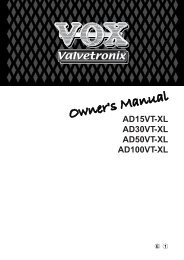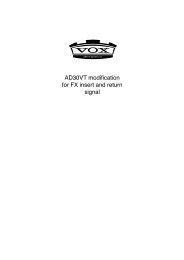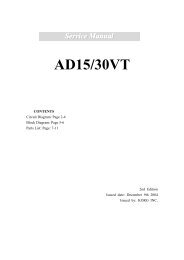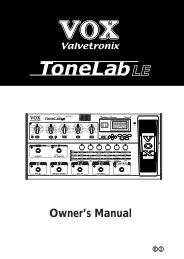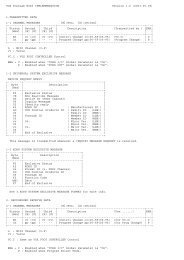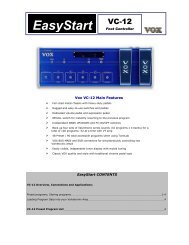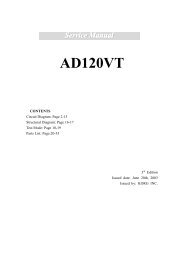ToneLab SE Owner's manual - Vox
ToneLab SE Owner's manual - Vox
ToneLab SE Owner's manual - Vox
Create successful ePaper yourself
Turn your PDF publications into a flip-book with our unique Google optimized e-Paper software.
6. Use the CABINET model selector to choose the cabinet you want.<br />
HINT: For recommended combinations of amp type and cabinet type, refer to p.34.<br />
7. Press the PRES-NR button and adjust NR <strong>SE</strong>NS (value knob 4) appropriately.<br />
Higher values of noise reduction (0.2, 0.4, ... 10.0) will produce a correspondingly<br />
greater effect. With a setting of “OFF” there will be no noise reduction.<br />
NOTE: We recommend that you use noise reduction if you’re using a high-gain setting<br />
such as the RECTO or US HIGAIN amp type, since high gain usually generates<br />
more noise. Depending on the guitar you’re using, raising the noise reduction<br />
excessively may cause some of your notes to be cut off unnaturally.<br />
HINT: You can set noise reduction independently for channels A and B.<br />
HINT: You can also specify a different amp or cabinet for channel B. To do so, press<br />
the channel select pedal to make the LED light red, and repeat steps 4–7.<br />
8. In each section, choose the effect you want to use. For example if you want to<br />
add spring reverb, use the REVERB selector to select SPRING 1 (or SPRING<br />
2).<br />
HINT: When you do so, the reverb model will automatically be turned on, the<br />
REVERB parameter line LED of the edit section will blink, and the LEDs below the<br />
value knobs will light to indicate the REVERB parameters. For example if you’ve<br />
selected SPRING 1, value knobs 1–4 will control TIME, LO DAMP, HI DAMP, and<br />
PRE DELAY, while value knob 6 will control MIX.<br />
9. To adjust the reverb mix amount, use value knob 6 which controls the MIX<br />
parameter.<br />
In the same way for PEDAL, MODULATION, and DELAY effects, use the<br />
selector to choose an effect and the value knobs to adjust the parameters.<br />
HINT: In some cases, it’s easier to adjust the PEDAL effect if modulation, delay,<br />
and reverb are not being applied. If you’re using the PEDAL effect, it’s best to make<br />
your amp and cabinet settings first, and then adjust the pedal effect before the<br />
other effects.<br />
NOTE: For some of the models, the name of the actual parameter you will be editing<br />
may differ from what is printed in the parameter line of the edit section. The<br />
name that appears in the display when you operate a value knob is the actual<br />
name. For details on parameters refer to p.35.<br />
10. If you want to continue making adjustments, simply press the select button for<br />
the model you want to edit, and turn the value knobs.<br />
If the EXPRESSION button lights when you operate a value knob, you have<br />
the option of assigning that parameter to an expression pedal. If you press and<br />
hold the EXPRESSION switch for at least one second, the parameter will be<br />
assigned to the expression pedal (EXP 1). (We call this the Expression Pedal<br />
Quick Assign function.) Now you can use the pedal to control that parameter<br />
while you perform. (Similarly, you can hold down the CONTROL switch to<br />
assign the parameter to expression pedal 2 (EXP 2).) For example if you set<br />
the PEDAL model selector to U-VIBE and use value knob 1 to adjust the<br />
SPEED parameter, the EXPRESSION button will light to indicate that you can<br />
use the above method to assign the SPEED parameter to the expression<br />
pedal. For details, refer to p.53.<br />
20




